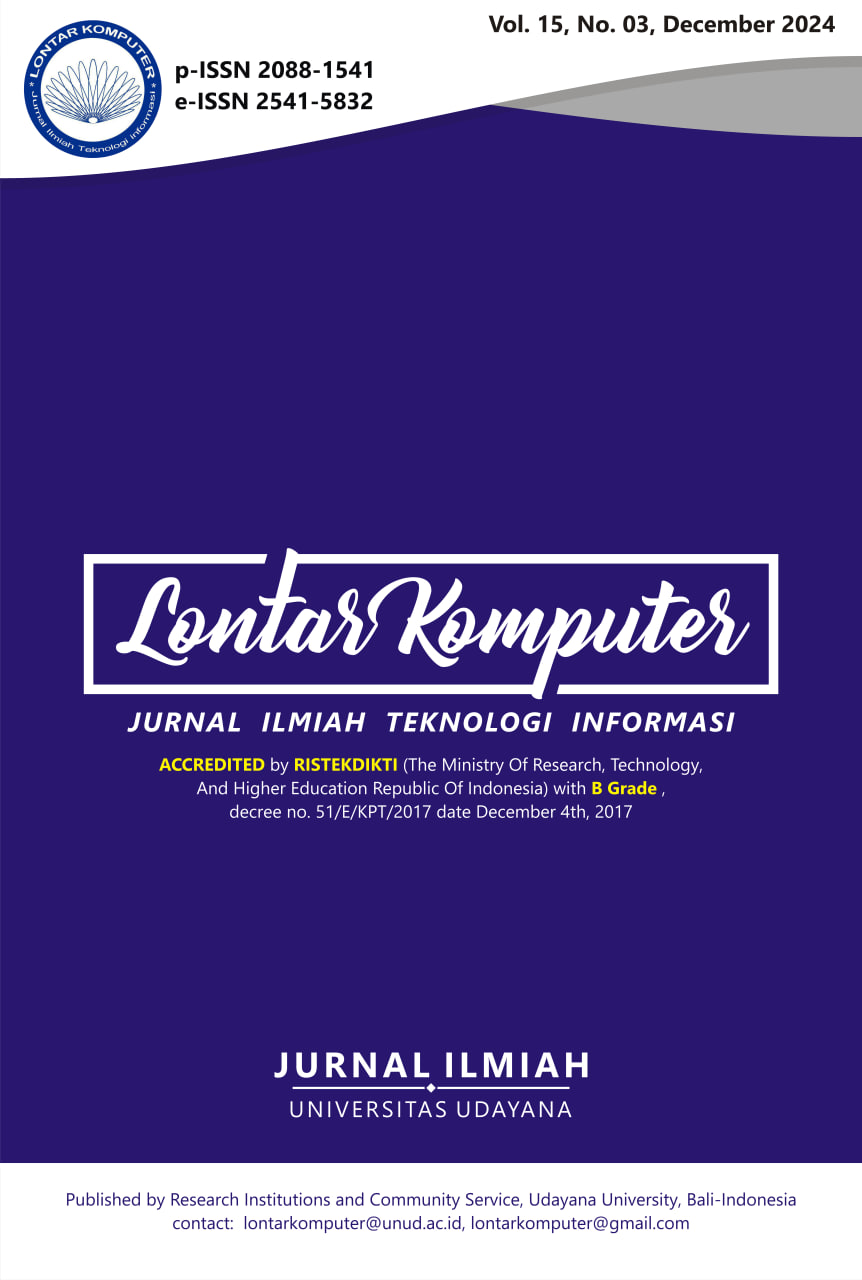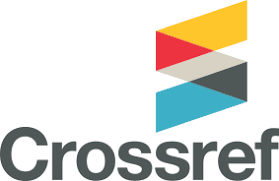Predicting the Number of Passengers in Public Transportation Areas Using the Deep Learning Model LSTM
Abstract
Accurate predictions of the number of public transport passengers on buses in each region are crucial for operations. They are required by the planning and management authority for bus public transport. A deep learning-based LSTM prediction model is proposed to predict the number of passengers in 4 bus public transportation areas (central, north, south, and west), evaluated by MSLE, MAPE, and SMAPE with dropout, neuron, and train-test variations. The CSV dataset obtained from Auckland Transport(AT) New Zealand metro patronage report on bus performance(1/01/2019-31/07/2023) is used for evaluation. The best prediction model was obtained from the lowest evaluation value and relatively fast time with a dropout of 0.2, 32 neurons, and train-test 80-20. The prediction model on training and testing data improves with the suitability of tuning for four predictions for the next 12 months with mutual fluctuations. The strong negative correlation is central-south, while the strong positive correlation is north-west. Predictions are less closely interconnected and dependent, namely central-south. With its potential to significantly impact policy-making, this prediction model can increase public transport mobility in each region, leading to a more efficient and accessible public transport system and ultimately enhancing the public's daily lives. This research has practical implications for public transport authorities, as it can guide them in making informed decisions about service planning and resource allocation.
Downloads
References
[2] J. Jalaney and R. S. Ganesh, “Multiple Extreme Learning Machines Based Arrival Time Prediction for Public Bus Transport” Intelligent Automation & Soft Computing, vol. 36, no. 3, pp. 2819–2834, 2023, doi: 10.32604/iasc.2023.034844.
[3] X.-G. Luo, H.-B. Zhang, Z.-L. Zhang, Y. Yu, and K. Li, “A New Framework of Intelligent Public Transportation System Based on the Internet of Things” IEEE Access, vol. 7, pp. 55290–55304, 2019, doi: 10.1109/ACCESS.2019.2913288.
[4] A. Vigren and R. Pyddoke, “The impact on bus ridership of passenger incentive contracts in public transport,” Transportation Research Part A: Policy and Practice, vol. 135, pp. 144–159, May 2020, doi: 10.1016/j.tra.2020.03.003.
[5] W. Wang, Y. Wang, G. H. de A. Correia, and Y. Chen, “A Network-Based Model of Passenger Transfer Flow between Bus and Metro: An Application to the Public Transport System of Beijing” Journal of Advanced Transportation, vol. 2020, pp. 1–12, Dec. 2020, doi: 10.1155/2020/6659931.
[6] H. Zhou, C. Yuan, N. Dong, S. C. Wong, and P. Xu, “Severity of passenger injuries on public buses: A comparative analysis of collision injuries and non-collision injuries” Journal of Safety Research, vol. 74, pp. 55–69, Sep. 2020, doi: 10.1016/j.jsr.2020.04.003.
[7] N. B. Dhital, L.-C. Wang, H.-H. Yang, C.-H. Lee, W.-H. Shih, and C.-S. Wu, “Effects of the COVID-19 pandemic on public bus occupancy and real-world tailpipe emissions of gaseous pollutants per passenger kilometer traveled” Sustainable Environment Research, vol. 32, no. 1, p. 35, Aug. 2022, doi: 10.1186/s42834-022-00146-7.
[8] R. Burdzik, W. Chema, and I. Celiński, “A study on passenger flow model and simulation in aspect of COVID-19 spreading on public transport bus stops” Journal of Public Transportation, vol. 25, p. 100063, 2023, doi: 10.1016/j.jpubtr.2023.100063.
[9] S. Liyanage, R. Abduljabbar, H. Dia, and P.-W. Tsai, “AI-based neural network models for bus passenger demand forecasting using smart card data” Journal of Urban Management, vol. 11, no. 3, pp. 365–380, Sep. 2022, doi: 10.1016/j.jum.2022.05.002.
[10] A. M. Nayak, A. Ladha, and N. K. Chaubey, “A Comprehensive Comparative Analysis of Passenger Demand Prediction for Improving the Urban Bus Transportation System (UBTS)” International Journal of Engineering Trends and Technology, vol. 70, no. 9, pp. 269–279, Oct. 2022, doi: 10.14445/22315381/IJETT-V70I9P227.
[11] I. Mariñas-Collado, A. E. Sipols, M. T. Santos-Martín, and E. Frutos-Bernal, “Clustering and Forecasting Urban Bus Passenger Demand with a Combination of Time Series Models” Mathematics, vol. 10, no. 15, p. 2670, Jul. 2022, doi: 10.3390/math10152670.
[12] F. M. A. Hassouna, “Sustainability assessment of public bus transportation sector in westbank, palestine” Environmental Research Communications, vol. 5, no. 1, p. 015001, Jan. 2023, doi: 10.1088/2515-7620/acb03f.
[13] R. Verma et al., “A Smartphone-Based Passenger Assistant for Public Bus Commute in Developing Countries” IEEE Transactions on Computational Social Systems, vol. 7, no. 2, pp. 465–476, Apr. 2020, doi: 10.1109/TCSS.2019.2961390.
[14] B. Jain, “Intelligent Bus Tracking and Passenger Counting System” Journal of Emerging Technologies and Innovative Research (JETIR), vol. 6, no. 4, 2019.
[15] R. Thiagarajan and Dr. S. Prakashkumar, “Identification of Passenger Demand in Public Transport Using Machine Learning” Webology, vol. 18, no. Special Issue 02, pp. 223–236, Apr. 2021, doi: 10.14704/WEB/V18SI02/WEB18068.
[16] W. T. Wu, K. Zeng, W. Zhou, P. Li, and W. Z. Jin, “Deep learning method for bus passenger flow prediction based on multi-source data and surrogate-based optimization” Jilin Daxue Xuebao (Gongxueban)/Journal of Jilin University (Engineering and Technology Edition), vol. 53, no. 7, 2023, doi: 10.13229/j.cnki.jdxbgxb.20210935.
[17] D. Luo et al., “Fine-Grained Service-Level Passenger Flow Prediction for Bus Transit Systems Based on Multitask Deep Learning” IEEE Transactions on Intelligent Transportation Systems, vol. 22, no. 11, pp. 7184–7199, Nov. 2021, doi: 10.1109/TITS.2020.3002772.
[18] Y. Liu, C. Lyu, X. Liu, and Z. Liu, “Automatic Feature Engineering for Bus Passenger Flow Prediction Based on Modular Convolutional Neural Network” IEEE Transactions on Intelligent Transportation Systems, vol. 22, no. 4, pp. 2349–2358, Apr. 2021, doi: 10.1109/TITS.2020.3004254.
[19] W. Lv, Y. Lv, Q. Ouyang, and Y. Ren, “A Bus Passenger Flow Prediction Model Fused with Point-of-Interest Data Based on Extreme Gradient Boosting” Applied Sciences, vol. 12, no. 3, p. 940, Jan. 2022, doi: 10.3390/app12030940.
[20] V. G S and H. V S, “Prediction of Bus Passenger Traffic using Gaussian Process Regression” Journal of Signal Processing Systems, vol. 95, no. 2–3, pp. 281–292, Mar. 2023, doi: 10.1007/s11265-022-01774-3.
[21] G. Cheng and C. He, “Analysis of bus travel characteristics and predictions of elderly passenger flow based on smart card data” Electronic Research Archive, vol. 30, no. 12, pp. 4256–4276, 2022, doi: 10.3934/era.2022217.
[22] Z. Xu, L. Hou, Y. Zhang, and J. Zhang, “Passenger Flow Prediction of Scenic Spot Using a GCN–RNN Model” Sustainability, vol. 14, no. 6, p. 3295, Mar. 2022, doi: 10.3390/su14063295.
[23] J. D. Zhao, J. Shen, and L. W. Liu, “Bus passenger flow classification prediction driven by CNN-GRU model and multi-source data” Jiaotong Yunshu Gongcheng Xuebao/Journal of Traffic and Transportation Engineering, vol. 21, no. 5, 2021, doi: 10.19818/j.cnki.1671-1637.2021.05.022.
[24] Z. Mei, W. Yu, W. Tang, J. Yu, and Z. Cai, “Attention mechanism‐based model for short‐term bus traffic passenger volume prediction” IET Intelligent Transport Systems, vol. 17, no. 4, pp. 767–779, Apr. 2023, doi: 10.1049/itr2.12302.
[25] F. Jiao, L. Huang, R. Song, and H. Huang, “An Improved STL-LSTM Model for Daily Bus Passenger Flow Prediction during the COVID-19 Pandemic” Sensors, vol. 21, no. 17, p. 5950, Sep. 2021, doi: 10.3390/s21175950.
[26] G. S. Vidya and V. S. Hari, “LSTM Network Integrated with Particle Filter for Predicting the Bus Passenger Traffic” Journal of Signal Processing Systems, vol. 95, no. 2–3, pp. 161–176, Mar. 2023, doi: 10.1007/s11265-022-01831-x.
[27] N. Nagaraj, H. L. Gururaj, B. H. Swathi, and Y.-C. Hu, “Passenger flow prediction in bus transportation system using deep learning” Multimedia Tools and Applications, vol. 81, no. 9, pp. 12519–12542, Apr. 2022, doi: 10.1007/s11042-022-12306-3.
[28] Auckland Transport, “AT Metro patronage report,” Wellington, 2023. [Online]. Available: https://at.govt.nz/about-us/reports-publications/at-metro-patronage-report
[29] M. M. Patel, S. Tanwar, R. Gupta, and N. Kumar, “A Deep Learning-based Cryptocurrency Price Prediction Scheme for Financial Institutions” Journal of Information Security and Applications, vol. 55, no. August, p. 102583, 2020, doi: 10.1016/j.jisa.2020.102583.
[30] H. K. Dam, T. Tran, T. Pham, S. W. Ng, J. Grundy, and A. Ghose, “Automatic Feature Learning for Predicting Vulnerable Software Components” IEEE Transactions on Software Engineering, vol. 47, no. 1, pp. 67–85, 2021, doi: 10.1109/TSE.2018.2881961.
[31] A. Mokhtar et al., “Estimation of SPEI Meteorological Drought Using Machine Learning Algorithms” IEEE Access, vol. 9, pp. 65503–65523, 2021, doi: 10.1109/ACCESS.2021.3074305.
[32] S. Ghimire, Z. M. Yaseen, A. A. Farooque, R. C. Deo, J. Zhang, and X. Tao, “Streamflow prediction using an integrated methodology based on convolutional neural network and long short-term memory networks” Scientific Reports, vol. 11, no. 1, p. 17497, Sep. 2021, doi: 10.1038/s41598-021-96751-4.
[33] Md. A. Istiake Sunny, M. M. S. Maswood, and A. G. Alharbi, “Deep Learning-Based Stock Price Prediction Using LSTM and Bi-Directional LSTM Model” in 2020 2nd Novel Intelligent and Leading Emerging Sciences Conference (NILES), IEEE, Oct. 2020, pp. 87–92. doi: 10.1109/NILES50944.2020.9257950.
[34] M. Nabipour, P. Nayyeri, H. Jabani, S. S., and A. Mosavi, “Predicting Stock Market Trends Using Machine Learning and Deep Learning Algorithms Via Continuous and Binary Data; a Comparative Analysis” IEEE Access, vol. 8, pp. 150199–150212, 2020, doi: 10.1109/ACCESS.2020.3015966.
[35] L. Mu, F. Zheng, R. Tao, Q. Zhang, and Z. Kapelan, “Hourly and Daily Urban Water Demand Predictions Using a Long Short-Term Memory Based Model” Journal of Water Resources Planning and Management, vol. 146, no. 9, Sep. 2020, doi: 10.1061/(ASCE)WR.1943-5452.0001276.
[36] Y. Jung, J. Jung, B. Kim, and S. Han, “Long short-term memory recurrent neural network for modeling temporal patterns in long-term power forecasting for solar PV facilities: Case study of South Korea” Journal of Cleaner Production, vol. 250, p. 119476, Mar. 2020, doi: 10.1016/j.jclepro.2019.119476.
[37] D. Xu, Q. Zhang, Y. Ding, and D. Zhang, “Application of a hybrid ARIMA-LSTM model based on the SPEI for drought forecasting” Environmental Science and Pollution Research, vol. 29, no. 3, pp. 4128–4144, Jan. 2022, doi: 10.1007/s11356-021-15325-z.
[38] S. Basheer, R. M. Mathew, and M. S. Devi, “Ensembling Coalesce of Logistic Regression Classifier for Heart Disease Prediction using Machine Learning” International Journal of Innovative Technology and Exploring Engineering, vol. 8, no. 12, pp. 127–133, Oct. 2019, doi: 10.35940/ijitee.L3473.1081219.
[39] S. Liyanage, R. Abduljabbar, H. Dia, and P.-W. Tsai, “AI-based neural network models for bus passenger demand forecasting using smart card data” Journal of Urban Management, vol. 11, no. 3, pp. 365–380, Sep. 2022, doi: 10.1016/j.jum.2022.05.002.
[40] Z. Wang, X. Su, and Z. Ding, “Long-Term Traffic Prediction Based on LSTM Encoder-Decoder Architecture” IEEE Transactions on Intelligent Transportation Systems, vol. 22, no. 10, pp. 6561–6571, Oct. 2021, doi: 10.1109/TITS.2020.2995546.
[41] M. S. Devi, S. Basheer, and R. M. Mathew, “Exploration of Multiple Linear Regression with Ensembling Schemes for Roof Fall Assessment using Machine Learning” International Journal of Innovative Technology and Exploring Engineering, vol. 8, no. 12, pp. 134–139, Oct. 2019, doi: 10.35940/ijitee.L3474.1081219.
[42] N. Singh, P. Sharma, N. Kumar, and M. Sreejeth, “Short-Term Load Forecasting Using Artificial Neural Network and Time Series Model to Predict the Load Demand for Delhi and Greater Noida Cities” in Lecture Notes in Networks and Systems, vol. 177 LNNS, 2021, pp. 443–455. doi: 10.1007/978-981-33-4501-0_41.
[43] H. Zheng, F. Lin, X. Feng, and Y. Chen, “A Hybrid Deep Learning Model With Attention-Based Conv-LSTM Networks for Short-Term Traffic Flow Prediction” IEEE Transactions on Intelligent Transportation Systems, vol. 22, no. 11, pp. 6910–6920, Nov. 2021, doi: 10.1109/TITS.2020.2997352.
[44] L. Liu et al., “Transient rotor angle stability prediction method based on SVM and LSTM network” Dianli Zidonghua Shebei/Electric Power Automation Equipment, vol. 40, no. 2, 2020, doi: 10.16081/j.epae.202001009.
[45] X. Xu and M. Yoneda, “Multitask Air-Quality Prediction Based on LSTM-Autoencoder Model” IEEE Transactions on Cybernetics, vol. 51, no. 5, pp. 2577–2586, May 2021, doi: 10.1109/TCYB.2019.2945999.
[46] Y. Liu, C. Lyu, X. Liu, and Z. Liu, “Automatic Feature Engineering for Bus Passenger Flow Prediction Based on Modular Convolutional Neural Network” IEEE Transactions on Intelligent Transportation Systems, vol. 22, no. 4, pp. 2349–2358, Apr. 2021, doi: 10.1109/TITS.2020.3004254.
[47] G. S. Vidya and V. S. Hari, “LSTM Network Integrated with Particle Filter for Predicting the Bus Passenger Traffic” Journal of Signal Processing Systems, vol. 95, no. 2–3, pp. 161–176, Mar. 2023, doi: 10.1007/s11265-022-01831-x.

This work is licensed under a Creative Commons Attribution 4.0 International License.
The Authors submitting a manuscript do so on the understanding that if accepted for publication, the copyright of the article shall be assigned to Jurnal Lontar Komputer as the publisher of the journal. Copyright encompasses exclusive rights to reproduce and deliver the article in all forms and media, as well as translations. The reproduction of any part of this journal (printed or online) will be allowed only with written permission from Jurnal Lontar Komputer. The Editorial Board of Jurnal Lontar Komputer makes every effort to ensure that no wrong or misleading data, opinions, or statements be published in the journal.
 This work is licensed under a Creative Commons Attribution 4.0 International License.
This work is licensed under a Creative Commons Attribution 4.0 International License.























